HOT & BOTHERED
The vital importance of irrigation
by TurfPro Editor, Laurence Gale MSC, MBPR
In these sweltering conditions the need for adequate irrigation is clearly highlighted, especially as the demand for better quality playing surfaces has increased.
Another great weekend of sport with the Rugby League cup final being played at a sweltering Wembley Stadium. Credit to all the players competing in such hot conditions with St Helens coming out winners 26 / 12.
We also saw the conclusion of the British Open played Sunday at Royal St George’s Golf Course in Kent, won by Collin Morikawa. Finally we witnessed Lewis Hamilton winning his 8th British Grand Prix at Silverstone.

A thought should be spared for all those turf professionals who had to prepare and repair these facilities during this mini heat wave.
This year’s spell of sunny hot weather has certainly arrived where I’m based in Shropshire - with the same seemingly applicable for most parts of the country. With air temperatures rising into the high 20s, there is no doubt that our playing surfaces are going to be under stress in more ways than one -especially if you do not have appropriate watering facilities on hand.
Irrigation
Most professional club facilities will have invested in a decent watering system, whether it is in the form of automated pop-up irrigation sprinklers or manually controlled watering devices such as boom spray irrigators, self-traveling and static sprinklers.

Those club facilities that do not have adequate watering facilities, they will have to rely on the weather and hope that some rain is forecast in the coming weeks. Hovever, the grass plant is quite resilient and can soon recover reasonably well after a dose of rain.
The problem becomes more acute if these hot periods drag on. We then begin to see the signs of heat stress and soils becoming hydrophobic. Once this happens, it generally takes longer for the turf to recover, often needing some intervention to overcome these issues.
Generally, the problem is more acute on sandy soils. Hydrophobic soil occurs when a waxy residue builds up on the soil particles resulting in it repelling water rather than absorbing it. It is most common in sandy soils, dried out potting mix and soils containing unrotted organic matter. You can identify hydrophobic soil by watering it. If water runs off or pools on the surface leaving the soil underneath dry, you've got Hydrophobic soil.
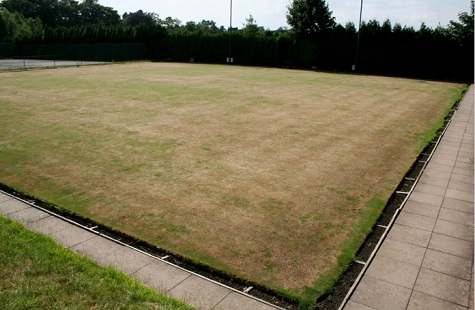
The application of wetting agents is a great quick fix but will not resolve the issue long term. Wetting agents work by breaking down waxy coatings as well as breaking the surface tension in the water making it easier to penetrate the soil. A better, long-term way to improve your soil is by adding well-rotted organic matter, then mulching over the top to help prevent the soil from drying out. This will introduce microorganisms to your soil which will break down the waxy residue and improving your soil biology.
However, this is generally more difficult to achieve on fine turf surfaces especially those predominantly constructed using sand based rootzones. Effectively it is then all about a preventive strategy of encouraging vigorous healthy growth by feeding with an array of organic feeds, applying wetting agents, employing a good aeration programme and above all having an effective watering system in place.
However, having said that, there are times when some clubs who do have a decent watering system, tend to go the other way and are applying and wasting too much water. This comes at a cost both in terms of finances (cost of water) as well as causing more turf related problems such as a build-up of thatch, weeds and diseases.

I know of one bowling club a few years ago who religiously put their pop-up watering system on every other night, come rain or shine and wondered why the green was so lush and spongy?
Nowadays, irrigation is an important and integral part of the turf grass management industry, especially as the demand for better quality playing surfaces has increased. This demand has been largely due to extensive televised coverage of major sporting events. Seeing immaculate aesthetically presented golf courses, football, rugby pitches and horse racing courses has increased the expectations of the players and viewers.
Most professional sporting facilities have irrigation systems of one sort or another. Without them they would not be able to prepare and maintain their playing surfaces.
Water balance
All grass plants are a continuum of water movement. Over 90% of the plant's water requirements are transported through the plant from the soil profile, via the roots and stem tissues into the leaves and out into the atmosphere. Knowledge of these relationships is important when designing and operating irrigation systems. The main aim is to achieve a water balance within the soil profile ensuring that the grass plant can access available water from the soil.
The soil water balance will be affected by several factors:
- Soil type and condition; the water holding capacity of soils will vary depending on their classification. Clay soils can hold more water than loamy or sandy soils, therefore soil type will affect and contribute to the amount of water required. Soils are continually going through phases of wetting and drying caused by local weather conditions.
- Weather; air temperature, daylight hours, solar energy inputs, wind speed and shading are factors that will affect evapotranspiration rates.
- Maintenance regimes: keeping the soil open and aerated will increase the drainage capacity of the soil. On the other hand, compacted soils will prevent the movement of water through soils, often creating an environment that prevents water getting down into the soil profile. By carrying out effective regular maintenance regimes that include aeration, scarifying, harrowing, brushing, top dressing all help to keep the soil in good condition.
- Irrigation system; type, capacity, running time, calibration and efficiency.
- Water resources; quantity and quality. The quantity of water available, and the amount licensed for use in any one year, will determine the performance of any system and irrigation capabilities.
- Facility type; design and construction. USGA greens perform differently to pushed up soil greens, each having different water and management requirements. Modern drainage systems also effect soil water conditions. Extensive drainage systems will freely drain water from the soil.
- Groundsman/Greenkeeper knowledge; it is important that there is someone who understands all of the above parameters and can access the water requirements of the turf and correctly implement the right irrigation schedule for the facility.
Advances in technology
Many years ago, groundsmen and greenkeepers considered themselves lucky to have a hose pipe and sprinkler available. During 1976, one of the hottest summers on record, whilst working at Cocksmoor Wood Golf Course, we were barely able to keep the greens alive. We only had a single diesel pump engine that pumped water from a stream, with the capacity to run only four hoses and sprinklers at any one time. Hours were spent moving and transporting the hoses and sprinklers to ensure all the greens received enough water to maintain the grass.
Technology has moved on, and we now see a wide range of irrigation systems from stand alone, self-travelling or boom sprinklers to computer controlled high-tech pop-up gear driven or jet sprinkler systems able to deliver precise amounts of water. Today many of the top golf courses have what is called wall to wall irrigation systems designed to irrigate greens, tees, approaches and fairways, enabling the course manager to have full control of his watering requirements.
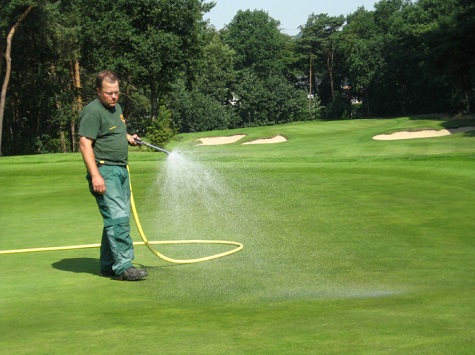
These systems do use a lot of water, albeit more effectively, so consideration needs to be given to the resource available. Is it mains, borehole, well, river or lake water? In most instances an abstraction licence will be required to obtain this water even though the source may be on club owned land.
Irrigation design engineers and manufacturers have now developed and offer a wide range of sprinkler products that can accommodate most facility requirement and applications. The employment of experienced irrigation specialists / consultants will ensure that the right system is employed and, in the long term, will save time and money.
So my advice for any club who are serious about improving the quality of their facilities in terms of turf quality and do not have an adequate watering system in place is to start raising funds and invest in the future procurement of a well-designed and appropriate irrigation system for your sport facilities. As I am sure these hot summers are only to get worse in the coming years if climate change continues to be the driving force for these extreme weather events.
 |
|
 |  |
£50M INVESTMENT IN GRASSROOTS FOOTBALL PITCHES ANNOUNCED
Funding available next year says government
In our first WEB ONLY story the Prime Minister announced last week an additional £50 million for grassroots football pitches, to boost the wave of national interest in EURO 2020 and Women’s EURO 2022, and inspire the stars of the future to take up the sport.
OPEN SUPPORT SUCCESS
Provided by Toro this weekend
In our next WEB ONLY story, assisting the talented greenkeeping team to create optimal course conditions at this weekend's The 149th Open at Royal St George’s were Toro machinery and irrigation.
BOSS APPOINTED SOLE UK & IRELAND DISTRIBUTOR FOR AIR-ROPS
Rollover safety for quads
BOSS ORV has announced they have been appointed distributor for the range of rollover solutions for the outdoor power equipment industry.
BOSS ORV has announced they have been appointed as the sole UK and Ireland distributor for all Air-Rops products.
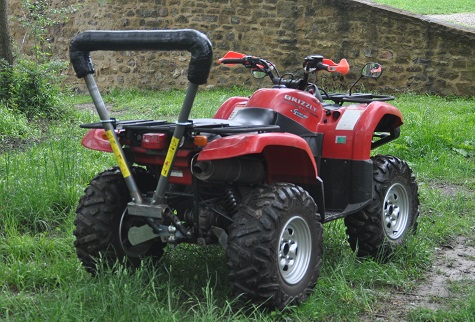
The company says Air-Rops offer a range of rollover solutions for the outdoor power equipment industry. In a statement the company explained, "ROPs on ATVs has always been a contentious issue but BOSS believe that in certain applications, and after a thorough risk assessment, they do offer additional protection for the operator. Air-Rops have the advantage over traditional ROPs of not raising the centre of gravity of the machine as it sits lower than the operator when not deployed."
The first Air-Rops product BOSS ORV has introduced is the AR Quad safety bar, for ATVs and agricultural machinery.
The company says this product uses Air-Rops technology in a fully automatic Roll Over Protection System. They base the technology on what they describe as "state-of-the-art automotive components, including safety electronics and proven and reliable airbag gas inflators".
The AR Quad electronic control unit continuously monitors the behaviour of the quad and warns the rider with acoustic and visual signals when the vehicle is about to reach a state where stability is compromised. The system automatically evaluates the rollover condition until a tilting state is reached and, only when the tilt takes place, activates the rollover bar. The electronic control unit operates the inflator, and the gas is fully released, extending the bar and the mechanism locks. The system only operates when the rider enters and cannot avoid the full tilt. The final position after deployment of the ROPS is limited to a maximum 90°, preventing full rollover which BOSS says not only helps minimise personal injury it also reduces damage to the quad.
The company says the universal AR Quad design fits most ATVs with independent suspension using bolts on the luggage carrier and towbar. Installation is easy as the system comes fully assembled and only requires the ATV dealer to perform simple electrical and mechanical actions. It requires no scheduled maintenance and is reusable after a rollover. It requires inspection and approval by an ATV technician, and the gas generator can be replaced to return the bar to its original condition. The system is SGS Certified and CE marked, adhering to environmental and regulatory standards.
Air-Rops will only be available through specialist approved dealers and regional distributors and will not be available by mail order or directly online. This, says BOSS, is to ensure that every unit is correctly installed and able to be monitored by the supplying dealer.
 |  |
CHAMPIONSHIP TREBLE FOR DEALER SUPPORT
Thomas Sherriff & Co and Double A on the case
The Scottish John Deere dealers will complete a unique treble this summer as they provide vital tournament support for three Open championships.
Scottish John Deere dealers Thomas Sherriff & Co and Double A will complete a unique treble this summer as they provide tournament support for the abrdn Scottish Open at The Renaissance Club in July, the Trust Golf Women’s Scottish Open at Dumbarnie Links and the AIG Women’s Open at Carnoustie Golf Links, both in August.
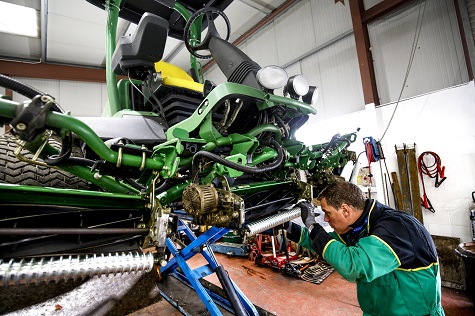
Dealer support for golf tournaments includes helping the greenkeeping team to keep the machinery fleet serviced and ready for work each day
This was The Renaissance Club’s third consecutive Scottish Open, with the course running an extensive John Deere equipment fleet including the new satellite guided GPS PrecisionSprayer and 2550E PrecisionCut hybrid electric greens mowers.
Sherriff Haddington turf sales manager Dougie Archibald arranged for the supply of additional 8000AE PrecisionCut hybrid electric fairway mowers, Gator utility vehicles and other support equipment to deputy head superintendent Jamie Aitken, who headed up the course maintenance team for the abrdn Scottish Open.
The dealership’s senior technician John Blair also spent two days before the tournament setting up the mower fleet to ensure all the machines achieved a consistently high quality finish.
Head superintendent Paul Seago says: “We are indebted to John Deere, local dealer Thomas Sherriff & Co and their respective staff for once again providing the tournament support fleet for the 2021 abrdn Scottish Open, without which we could not produce our course to the exacting standards required for hosting such a prestigious event.
Dumbarnie Links is a new venue for the Women’s Scottish Open, and this will be the first major golf tournament hosted by Scotland’s newest golf course, which only opened for play officially at the end of May last year. The course also operates a number of E-Cut hybrid electric mowers as part of its John Deere fleet, supplied by Double A from its main Cupar outlet in Fife.
The dealership was involved with the Dumbarnie Links project from the very beginning, and since the initial supply of John Deere equipment on loan Double A group sales manager Ross Kelly and golf key accounts manager John Bateson have been phasing in a full range of course maintenance equipment over the past three years.
“It’s simply not possible to achieve what we want to achieve without the extra machines and technical support we get from Double A and John Deere,” says Dumbarnie Links course manager Grahame Taylor. This will include additional hybrid greens, fairways and surrounds mowers plus HPX Gator utility vehicles, with John Bateson also cutting aprons throughout the tournament using a new 2750E PrecisionCut machine.
Carnoustie Golf Links, known as ‘Golf’s Greatest Test’ and a flagship for innovation and sustainable golf course management, entered into a new partnership agreement with John Deere and Rain Bird in 2020. It is also taking advantage of developments in precision technology, with an equipment fleet that includes three of the first new GPS PrecisionSprayers to be sold in Europe.
The AIG Women's Open returns after 10 years to Carnoustie for the 45th playing of the championship in 2021, with the famous Angus course becoming the fifth links venue in history to host the event multiple times.
Carnoustie Golf Links courses manager Kevin Stott says: “Reliable manufacturer and dealer support such as that provided by John Deere and Double A is very important. Hosting a major tournament such as the AIG Women’s Open requires the extra kit and manpower to help our team put that extra polish on the fairways and greens, and make maximum use of the available daylight hours."
 |  |
REESINK APPOINT NEW MANAGER FOR EAST ANGLIA BRANCH
Industry stalwart Trevor Chard
Reesink Turfcare’s new East Anglian branch in Burwell between Cambridge and Newmarket, which will open this autumn has appointed its branch manager.
Reesink Turfcare’s new East Anglian branch in Burwell between Cambridge and Newmarket, which will open this autumn has appointed its branch manager.
The successful applicant for the role is Trevor Chard, an industry - and Reesink - stalwart.
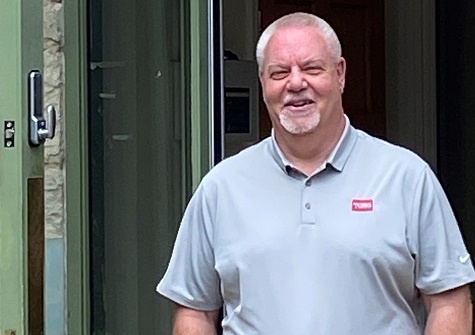
Trevor Chard
Trevor Chard is a name well-known by those in the golf and fine turf industry having been national accounts manager for Reesink Turfcare for 25 years. The move to branch manager is, he says, one that will give him a new experience and challenge, along with the opportunity to share his knowledge from years in one of the company’s key customer-relationship roles.
Trevor says, “The opening of the East Anglian branch is widely-anticipated for customers in the area, and I am really excited to be heading up the branch. I’ve worked for Reesink for years and loved it, but it was time for a new challenge in a role with fewer miles travelling the country. The new branch will focus on dealing directly with customers, adding value and building relationships, and that takes the part of my role that I’ve loved so much up until now and continues it in a new and fresh way.
“The branch has an extensive catchment of Norfolk, Suffolk, Cambridgeshire, Essex, Leicestershire and Northamptonshire and includes some key Toro customers. Our role will be to provide those customers, and new ones, with dependable maintenance and genuine parts after-sales service. There will be a demo fleet to use for new business and a range of other services available such as NSTS testing and on-site servicing.”
Similarly to the other Reesink branches, the East Anglian one will be an independently-run business, about which Trevor says: “Removing the element of being centrally-controlled and being more local to our customers will allow us to react quickly. We will be focussed on fast, easily accessible, friendly help and support.”
The East Anglia branch will follow the same business model applied by Reesink Turfcare to the Sheffield Park branch in the South East and the Livingston branch in Scotland.
David Cole, Reesink Turfcare’s managing director, said, “When investing in a new location, the leadership of that branch is of paramount importance to ensure that each individual shares and understands the Reesink passion for machinery and a down-to-earth approach to providing solutions. When filling that role for our new investment for the East Anglian region we quite rightly encouraged internal applicants to step forward, but they had to win the position based on skill set, experience and above all, attitude, against outside candidates. We are very pleased that Trevor won through in the process.
“We look forward to our Burwell location opening in the early autumn, and know that Trevor, Liam Pindred, the service manager and the rest of the team are excited and ambitious about making a difference to our customers across the region the branch will serve.”
The company says the opening of the branch will be celebrated with an Open Day, to be announced in due course.
 |  |
IN-TREE TRAINING AT GIE+EXPO
Plus arborist workshops
Attendees of GIE+EXPO this October have the opportunity to learn arborist techniques from certified arborists who will be aloft in a 50-foot tree set up inside the Kentucky Exposition Center.
Attendees of GIE+EXPO this October 20-22 in Louisville, Kentucky. have the opportunity to learn arborist techniques from certified arborists who will be aloft in a 50-foot tree set up inside the Kentucky Exposition Center.
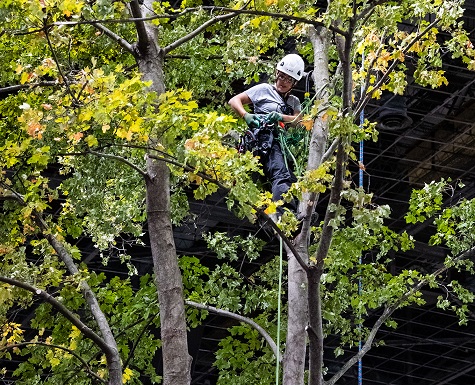
Melissa LeVangie and Bear LeVangie, of the Women’s Tree Climbing Workshop along with their team, will present eight in-tree demonstrations and two new classroom workshops. The LeVangies developed the Women’s Tree Climbing Workshop in 2009 with a mission “to create a safe, encouraging, and empowering learning environment for women to climb trees” and have hosted workshops across the United States for both women and men."
Ken Osberg, director of marketing for Echo, one of the sponsors of the activity, said, "GIE+EXPO is the industry’s family reunion as Kris Kiser refers to it, and we at Echo can’t agree more. The tree climbing and workshop program is yet another innovative way the show is engaging attendees in fun and educational activities."
The in-tree demonstrations throughout the day Wednesday-Friday will cover a wide range of topics, including tie-in points, the use of drones, fundamentals of pruning cuts and static vs dynamic rigging. These sessions are included with trade show registration.
In addition, two classroom workshops will offer Certified Arborists the opportunity earn CEUs.
- Wednesday, October 20, 10:00 AM - 1:00 PM: Gear Inspection for Tree Climbers
- Friday, October 22, 10:00 AM - 1:00 PM: How to Grow Your Green Business and Why?
There is a fee of $85 per workshop, and registration is required for these.
 |
|
 |  |
ADVERTISE YOUR JOBS HERE
Amazing success rates!
Advertise your recruitment needs on TurfPro Weekly Briefing and reach our targeted audience of recipients every week.
Contact Nikki Harrison for details - 01491 837117
|
GIE+EXPO – LOUISVILLE, USA
The international landscape, outdoor living and equipment show
GIE+EXPO returns to the Kentucky Exposition Center, between the 20-22nd October 2021, offering new features including a 4,000sqft hands-on Drone Zone and a UTV Test Track.

Visit the Kentucky Exposition Center, between the 20-22nd October 2021, to take part in GIE+EXPO’s:
- 4,000sqft hands-on Drone Zone
- UTV Test Track for driving and comparing the latest vehicles on real terrain
- Remote Pilot Certification Course
- Arborist demos and classroom courses
- Keynote presentation from Admiral James Stavridis
- Free dealer workshops by Bob Clements International, as well as much more…
Visit gie-expo.com to find out more.
|
 |  |
EDITOR'S BLOG ARCHIVE
Catch up with Laurence Gale's recent blogs
Want to catch up with one of editor Laurence Gale's blogs? Here is the place to do so.
TURFPRO FEATURE ARCHIVE
Find our previous features here
If you want to catch up with any of TurfPro's previous features, here is the place to do so.
WORKING ON A TIGHT BUDGET
Nenagh Golf Club
ON A MISSION
Wrekin Golf Club aiming to enrich wildlife and fauna
WILD AND WONDERFUL
Design By Nature
LEARNING HOW TO SURVIVE
Abbey Par 3
TACKLING OBESITY
Vital that schools can provide sport
A LIFETIME OF LEARNING
Vital for turf professionals
CELEBRATING 125 YEARS
Tullamore Golf Club
UNIVERSITY CHALLENGES
At Trinity College Dublin
BLENDING THE OLD WITH THE NEW
Bray Golf Club
A WELL POLISHED COURSE!
Ierne Social And Sports Club
IDENTIFYING THE TRUE VALUES
Of grounds maintenance
THE INDUSTRY WILL CHANGE & ADAPT
But it will survive
WIRRAL GOLF COURSES SAVED
Renewed hope and optimism for the future
GREEN SPACE CONTRIBUTION TO WELLBEING IS UNDERVALUED
Parks invisible on national agenda
A SHINING LIGHT IN IRELAND'S SUNNY SOUTHEAST
Wexford Golf Club
GREEN SPACES DO NOT LOOK AFTER THEMSELVES!
Keith Kent says we must invest in people
WE SHOULD TELL THE WORLD ABOUT THE UK INDUSTRY
Right time for all sides to come together
SOIL LIFE IS PRECIOUS
Good-quality soil can help save the planet
MORE THAN JUST CUTTING GRASS
Encouraging the next generation
A BUZZ FROM DOING THE JOB
Wide experience of the turf grass industry
PAYING THEIR WAY
Low wages is the bane of the industry
AMENITY MANAGEMENT IMPACTS US ALL
Professor John Moverley
CARING FOR PARKS OF ALL TYPES
Mary Worrall
TOP FIVE FRUSTRATIONS FOR CRICKET GROUNDSMEN
What causes you the most frustration in your role?
PROFESSIONALS AT THE CUTTING EDGE
Vic Demain and Phil Sharples
BOWLS CLUBS IN PERIL
A sad decline
A VERY SPECIAL INDUSTRY
Loz looks back
SNEAK PEAK AT A ROBOTIC "GAME CHANGER"
Commercial model capable of covering 50,000 m2 teased
HALESOWEN PICK A BIG ROBOT UP FRONT
Invest in mowers
COMPRESSED AERATION
The new way
PARKS MATTER MORE THAN EVER
Recent sector developments
ON TEST
STIHL blowers
THREE CORE VALUES TO SHAPE OUR INDUSTRY
Real concerns for the future
ENGLAND'S GREEN SPACE GAP
A split along racial lines
ON TEST
EGO STX3800 strimmer with RTX2300 Rotocut head
A SECTOR FACING IMPORTANT TIMES
Review of the National Action Plan
PARKS MATTER
The role of public parks in the recovery: a discussion paper
A UNIQUE SPORTING VENUE
Wormsley private estate
A BTME OUTDOORS?
A good bet for the industry
PARKS NEED APPROPRIATE POLITICAL REPRESENTATION
Q&A with Philippa Reece, Parks and Foreshore Manager at Adur and Worthing Council
CRICKET LOAM
What does it mean?
A HERCULEAN EFFORT TO GET PARKS BACK TO NORMAL
Q&A with Chris Worman, Rugby Borough Council’s parks and ground manager
ON TEST
STIHL battery products
TURFGRASS STRESS MANAGEMENT
Reactive Oxygen Species (ROS) and antioxidants during biotic and abiotic stress in turfgrass plants
AUTUMN DISEASE MANAGEMENT
The coming months are going to prove very difficult
THE ABUSE OF PARKS . .
Is the abuse of society
WHY PARKS MATTER?
A statement from the Parks Management Forum to the Prime Minister
THE 21st CENTURY PARKS MANAGER
Innovative, creative and entrepreneurial
EAT, SLEEP, CUT, REPEAT!
Cricket under covid
TIME FOR A SINGLE SHOW?
Debate brought back into focus
A CHALLENGING TWO MONTHS
Running golf design projects from home
PRESSURE SITUATION
Cementing the reputation
A CLUB TO BE PROUD OF
10 years at the helm of Olton GC
GAME CHANGERS IN TURFCARE
The day the Lord's outfield reconstruction proved its worth
THE ESSENCE OF ESSENTIAL
Finding a sensible way forward on defining "essential maintenance"
THAT WAS THE YEAR THAT WAS
2001
HOW TO LOOK AFTER A GOLF COURSE WITH NO GOLFERS
Fundamental to the survival of almost all courses, if not of the game itself
RAIN STOPPED PLAY WOULD BE WELCOME
. . along with ‘lunch is being taken early’
PHYSICAL CONTROL OF TURFGRASS PESTS
An urgent problem
A DIVERSE & ENTERTAINING WEEK
Successful BTME 2020
INTEGRATED PEST CONTROL
Opportunity to embrace new methods
ENVILLE ON THE UP
Major investments taking place
GREEN FLAG AWARDS 2019
A great success
U.S PROFESSIONAL EQUIPMENT SHOW EXCELS
Buoyant GIE+EXPO
LEGACY OF THE SOLHEIM CUP
At Gleneagles
A DAY OUT WITH THE LADIES
Behind the scenes at the Solheim Cup
COVENTRY UNIVERSITY'S EDIBLE GARDEN SUCCESS
2006 - present
HAIL THE GRASS MASTERS!
Boorish media comments about pitch quality are wide of the mark
CONTRACTOR SEES MULTI-DISCIPLINE SUCCESS
360 Ground Care serving professional facilities
BUSY TIMES
Judging the Green Flag Awards
TAKING AN INTEGRATED APPROACH
What does it all mean in managing turf surfaces?
UNDER PRESSURE
Dry weather conditions continue to keep turf managers focused on moisture management
EDDIE SEAWARD
Death of Wimbledon’s influential grounds manager
MAJOR NEW IRRIGATION PROJECT
At Top 100 classic Berkhamsted Golf Club
NEW HORIZONS FOR THE HATTERS
Investment paying off at Kenilworth Road
ELIZABETHAN RESTORATION
At Castle Bromwich Hall Gardens
WHAT IS BIOPHILIA?
The vital impact of parks and green spaces on health and well-being
WORM CONTROL
Without carbendazim
THE TRUE COST OF PETROL
Battery-powered outdoor power tools are now turning the heads of professionals
SANDS OF TIME
Sand-based pitches are now the norm in professional sports
WHY DO WE DO THE RIGHT THING?
We must maintain industry standards
CHASING GRASS PERFECTION?
11 things you need to know . . .
MAINTAINING STANDARDS
Q&A with BASIS ceo, Stephen Jacobs
STRI RESEARCH DAY 2018
Hosted at research trial grounds in Bingley
THE MECHANIC
Leicester City FC invest in new role
LORD'S 'GRASS-GUVNOR' TO RETIRE
Mick Hunt bows out after 49 years
HOLLOW CORING & DEEP SCARIFICATION
Is it really necessary?
 |
|
 |  |
 |  |
 |  |
 |  |
FROM ACROSS THE IRISH SEA
|
GO WEST
Inishturk GAA pitch – one of the most westerly sportspitches in Europe
by Alan Mahon, TurfPro's Ireland editor (Words & Pictures)

A football pitch situated on a remote island in the Atlantic Ocean is looked after Eamon Heanue, who tells TurfPro about the unique maintenance regime required for such an unusual setting.
It’s not often that you get the opportunity of visiting a football pitch that is situated on a remote island in the Atlantic Ocean. This opportunity came to me when I visited the island of Inishturk, which takes almost an hour to travel the 9 mile boat trip from Roonagh Pier, near Louisburgh in County Mayo.
Inishturk is a rugged island measuring 5km x 2.5km (3 miles x 1.5 miles) with a population of seventy people. Most of the residents live around the main harbour. Electricity was only introduced there in 1983.
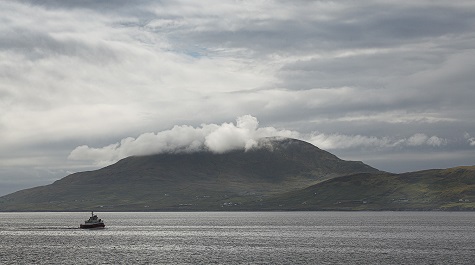
The Inishturk ferry travels the 9 mile journey to Roonagh pier to collect its passengers as it passes by Clare Island
I was met at the pier at Inishturk by Eamon Heanue who, among other things, maintains the one and only football pitch on the island. It was 7:30 in the evening. He couldn’t meet me any earlier as he had brought anglers out on a fishing trip earlier that day. Eamon is also a sheep farmer. Being an islander one has to have many trades to earn a living.
Eamon drove me up the hilly roadway to the pitch and when we arrived I was amazed at the sight of it. It was like an oasis in the desert, nestled among the craggy hills. This pitch is one of the most westerly sportspitches in Europe exposed to the wild Atlantic. It is situated on the island’s flattest terrain, which is regularly maintained by Eamon and he has been doing this since 2010.
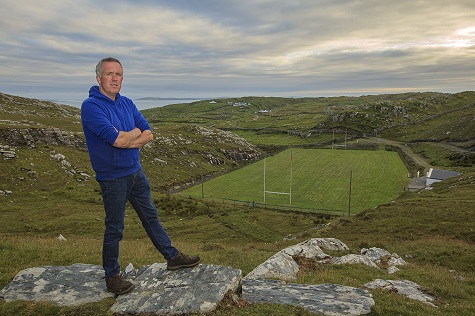
On top of the world. Groundsman Eamon Heanue with the southern view of Inishturk GAA pitch behind him
What is unusual about the pitch is that it is surrounded by hills with outcrop of rock, forming a natural amphitheatre that, if it wanted to, could easily accommodate over 10,000 spectators. However, transporting that number of people across the ocean and providing refreshments would provide a logistical headache.
So how did the idea of building a pitch come about? “When we were growing up on the island as children many of us would come up here and kick a ball and have friendly football matches but the ground was too uneven to hold formal games here”, said Eamon. Indeed football has been played on the site for generations in one form or another. It was only as recently as 1996 that the club was formed as there was a strong and vibrant generation of players at that time in both women’s and men’s teams so it was an easy decision to form a club and provide some organised football and other activities.
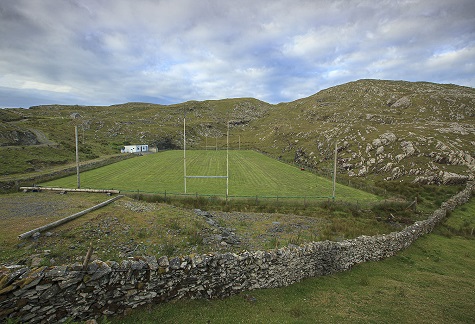
A view of the pitch looking North. The rock surrounding it forms a natural amphitheatre
Over the years, the pitch has been developed bit by bit. The local community employment schemes have been involved with the pitch development since the early 1990s and has been vital in getting the field to where it is today. This work is facilitated through the local community council on the island. Major redevelopment of the field took place from 1993-95. This involved new main drainage and levelling of the surface.
In 2008 the local community got together to raise funds for more development of the pitch. They got a lot of funding from the Department of Arts, Heritage and the Gaeltacht, but much of the work, particularly on the dressing rooms, was done through local voluntary labour.
This work involved levelling the ground, and, to conform to GAA pitch size requirements, some rock had to be removed from one of the corners to accommodate a full size pitch. A herringbone drainage system was installed. This took two years to complete. The community rural social scheme also provided funds to maintain the pitch, of which Eamon is in charge.
Eamon uses a ride-on rotary mower to mow the grass. “In the beginning I put fertiliser on the pitch but found that the extra nitrogen encouraged moss. I have since stopped doing this. Every second cut I now remove the clippings, the other times the grass is left on the ground, which helps feed the grass”, said Eamon.
There are limitations when it comes to maintaining an island pitch such as Inishturk. For example carrying out regular sand topdressing is unrealistic (and expensive) as it would be difficult to transport such large quantities of sand from the mainland. Despite these limitations Eamon is doing a great job in keeping the pitch in good condition.
In 2013 the building of dressing rooms began and was completed and officially opened the following year. This was a great addition to have, as it meant that visiting teams could now be looked after, as the new building contained two dressing rooms, with showering facilities in each.
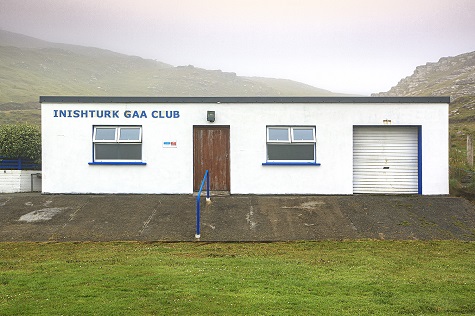
The dressing rooms, which were officially opened in 2014
As time moved on and with a population of only seventy, it was difficult to continue with a team from the island. While watching the island games at other venues the club decided to invite players from nearby Clare Island and Inishbofin to get together as a team and take part in the Galway League. Even though Inishturk is off County Mayo, the postal address of the island is in Galway. This worked for a while but travelling to Galway was a long journey so it wasn’t long before they changed to taking part in the West Mayo Junior ‘B’ Championship and Division 5 of the Mayo League under the name Na h-Oileáin (meaning The Islands).
Inishturk GAA club is not a registered club but is affiliated with Mayo GAA county board. It takes part in the All Island Gaelic Football Championship each year. This involves teams competing from ten islands around Ireland. The club hosted the tournament in 2012 and 2015. On both occasions the visiting teams were looked after by the locals, who provided them with accommodation. Army tents were brought in to cater for the overflow of competitors.
Due to the economic situation in Ireland most of the players no longer reside on the island and the GAA grounds are not used as much as they would like. No matches have been played on the pitch since the start of the coronavirus pandemic.
Eugene O’Toole is the Club Secretary. He is a former player with the club and he knows a lot about the club’s history. Eugene now works and lives on the mainland. “It’s a pitch that appears out of nowhere as you’re coming up the road. You would never think approaching the area that there was a pitch actually there. It is there, and we’re proud of it”, he said. Even though Eugene lives and works on the mainland, he still comes to the island on most weekends as his parents still live there. He is very involved with the running of the pitch. He often reflects on the wonderful times he had as a player “We actually won our only All-Islands tournament in 2008 without a field to train on! We trained on the beach. What Great memories we have of that”, said Eugene.
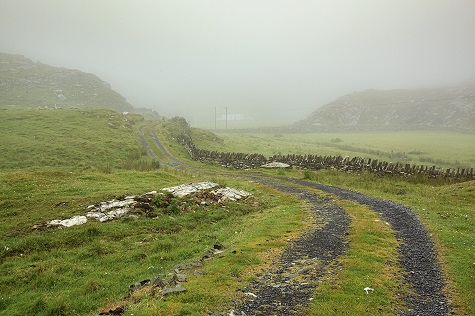
The main road to the pitch shrouded by Celtic mist. You can just about see the dressing rooms in the distance
In March 2020, before Leo Varadker made his famous lockdown announcement in Washington, the residents of Inishturk took the decision that they would isolate on the island and only travel to the mainland on exceptional circumstances. When restrictions eased during the summer of 2020 the island was slowly reopened for visitors but they were not allowed stay overnight. These decisions proved to work as the island remained Covid free during the sixteen month period of the pandemic. “This was great for us as the whole island was treated as one bubble, which meant that we could visit one another, especially our parents, without the fear of giving each other the virus”, said Eamon. However, the downside of this was that any islanders who worked and lived on the mainland couldn’t visit their relatives for several months.
With so little football being played, the local community came up with the idea of alternative uses for the pitch. Taking advantage of the island’s clear night skies with no light pollution, one such idea is renting the pitch out for glamping. Special glamping tents were bought and these have become very popular. This is a great way to camp out at night and watch the stars.
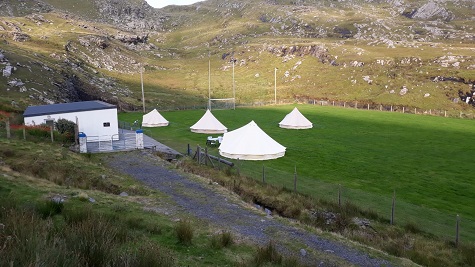
Glamping tents erected on the pitch. Photo courtesy Eugene O’Toole
There is huge potential for the pitch to be hired to other clubs and used as a centre to host football or hurling camps. A training programme for a weekend or even a full week would not be hard to work out. Not only could the pitch be used to train on but the surrounding hills would make for ideal running treks for teams to train. Being a small island, the sea is never too far away to cool down or have some swimming exercises as well. The isolation of the place would make it an ideal location for team bonding. With the dressing rooms and shower facilities available, what’s not attractive about that?
I feel privileged to have visited Inishturk GAA pitch and to have met Eamon Heanue and having the phone chats with Eugene O’Toole. I would say it is probably the nicest pitch I have written about. I hope football will continue to be played there for generations to come and that the pitch will continue to improve and mature over time.
 |
|
|
|